Sweden's Leadership in Gender Equality at Workplaces
VerifiedAdded on 2023/05/31
|10
|3025
|82
AI Summary
The article discusses the progress of gender equality in Sweden and the issues faced by women in workplaces in UK. It also highlights the policies and measures taken by Sweden to promote gender equality and the need for other countries to follow suit.
Contribute Materials
Your contribution can guide someone’s learning journey. Share your
documents today.
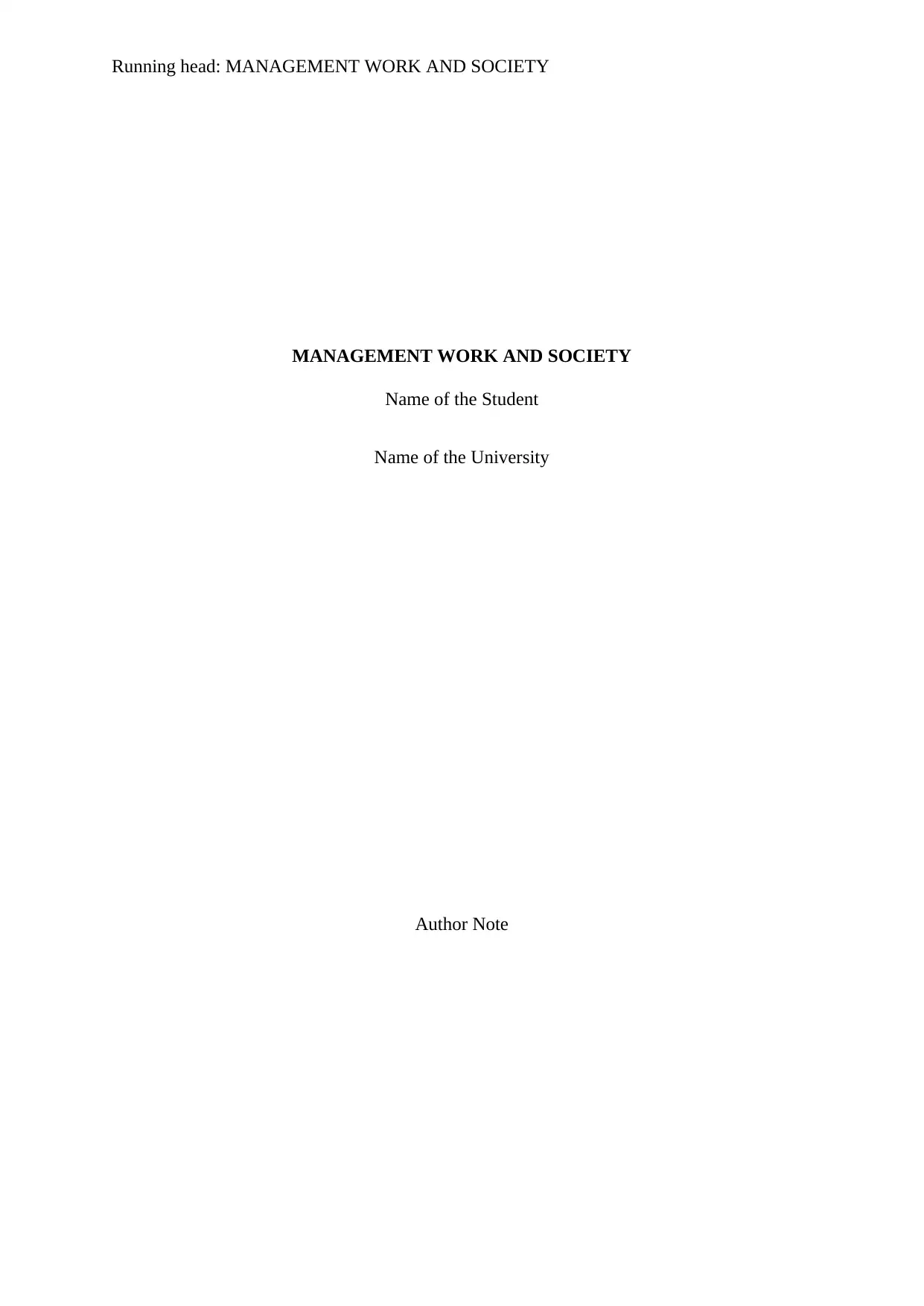
Running head: MANAGEMENT WORK AND SOCIETY
MANAGEMENT WORK AND SOCIETY
Name of the Student
Name of the University
Author Note
MANAGEMENT WORK AND SOCIETY
Name of the Student
Name of the University
Author Note
Secure Best Marks with AI Grader
Need help grading? Try our AI Grader for instant feedback on your assignments.
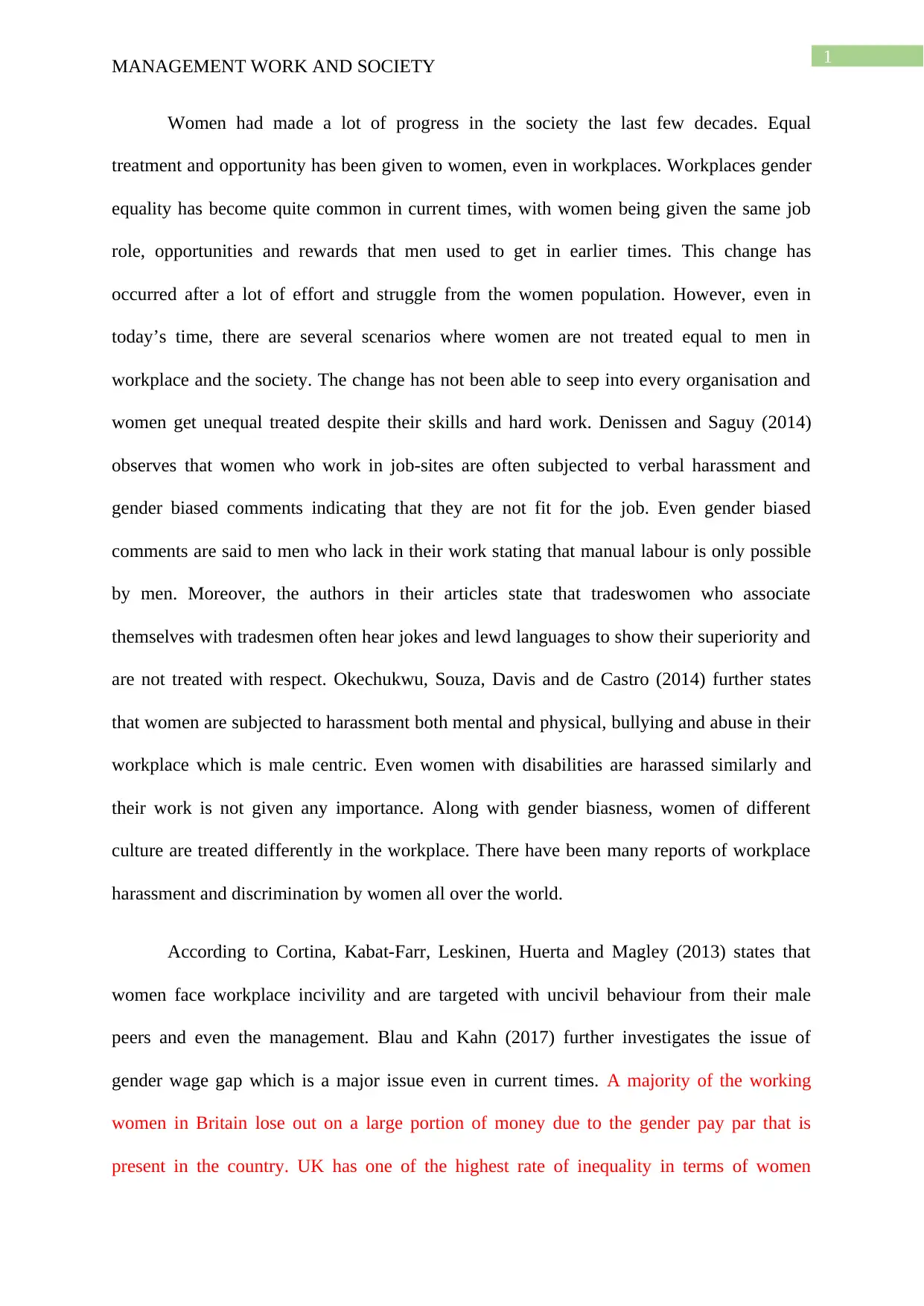
1
MANAGEMENT WORK AND SOCIETY
Women had made a lot of progress in the society the last few decades. Equal
treatment and opportunity has been given to women, even in workplaces. Workplaces gender
equality has become quite common in current times, with women being given the same job
role, opportunities and rewards that men used to get in earlier times. This change has
occurred after a lot of effort and struggle from the women population. However, even in
today’s time, there are several scenarios where women are not treated equal to men in
workplace and the society. The change has not been able to seep into every organisation and
women get unequal treated despite their skills and hard work. Denissen and Saguy (2014)
observes that women who work in job-sites are often subjected to verbal harassment and
gender biased comments indicating that they are not fit for the job. Even gender biased
comments are said to men who lack in their work stating that manual labour is only possible
by men. Moreover, the authors in their articles state that tradeswomen who associate
themselves with tradesmen often hear jokes and lewd languages to show their superiority and
are not treated with respect. Okechukwu, Souza, Davis and de Castro (2014) further states
that women are subjected to harassment both mental and physical, bullying and abuse in their
workplace which is male centric. Even women with disabilities are harassed similarly and
their work is not given any importance. Along with gender biasness, women of different
culture are treated differently in the workplace. There have been many reports of workplace
harassment and discrimination by women all over the world.
According to Cortina, Kabat-Farr, Leskinen, Huerta and Magley (2013) states that
women face workplace incivility and are targeted with uncivil behaviour from their male
peers and even the management. Blau and Kahn (2017) further investigates the issue of
gender wage gap which is a major issue even in current times. A majority of the working
women in Britain lose out on a large portion of money due to the gender pay par that is
present in the country. UK has one of the highest rate of inequality in terms of women
MANAGEMENT WORK AND SOCIETY
Women had made a lot of progress in the society the last few decades. Equal
treatment and opportunity has been given to women, even in workplaces. Workplaces gender
equality has become quite common in current times, with women being given the same job
role, opportunities and rewards that men used to get in earlier times. This change has
occurred after a lot of effort and struggle from the women population. However, even in
today’s time, there are several scenarios where women are not treated equal to men in
workplace and the society. The change has not been able to seep into every organisation and
women get unequal treated despite their skills and hard work. Denissen and Saguy (2014)
observes that women who work in job-sites are often subjected to verbal harassment and
gender biased comments indicating that they are not fit for the job. Even gender biased
comments are said to men who lack in their work stating that manual labour is only possible
by men. Moreover, the authors in their articles state that tradeswomen who associate
themselves with tradesmen often hear jokes and lewd languages to show their superiority and
are not treated with respect. Okechukwu, Souza, Davis and de Castro (2014) further states
that women are subjected to harassment both mental and physical, bullying and abuse in their
workplace which is male centric. Even women with disabilities are harassed similarly and
their work is not given any importance. Along with gender biasness, women of different
culture are treated differently in the workplace. There have been many reports of workplace
harassment and discrimination by women all over the world.
According to Cortina, Kabat-Farr, Leskinen, Huerta and Magley (2013) states that
women face workplace incivility and are targeted with uncivil behaviour from their male
peers and even the management. Blau and Kahn (2017) further investigates the issue of
gender wage gap which is a major issue even in current times. A majority of the working
women in Britain lose out on a large portion of money due to the gender pay par that is
present in the country. UK has one of the highest rate of inequality in terms of women
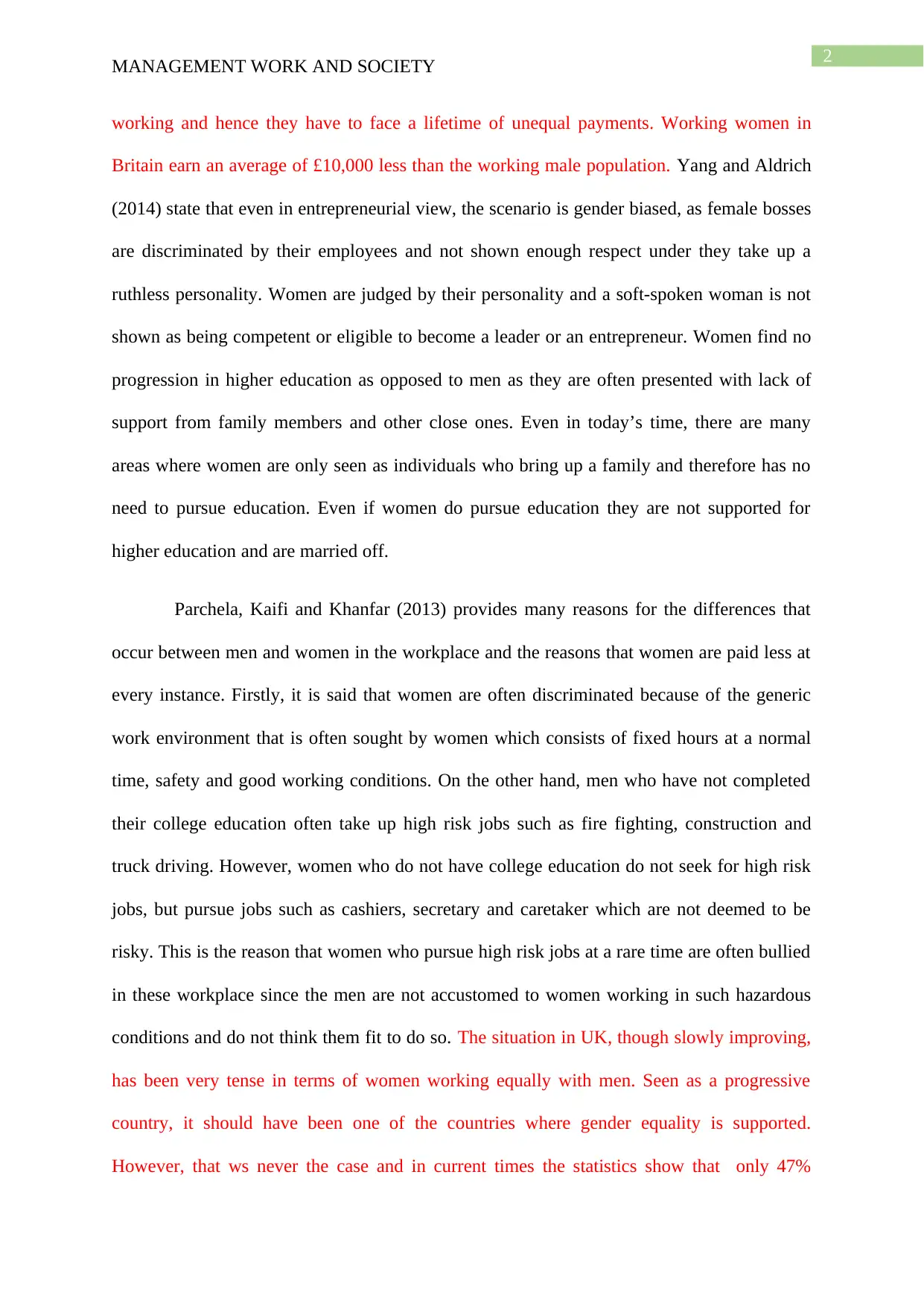
2
MANAGEMENT WORK AND SOCIETY
working and hence they have to face a lifetime of unequal payments. Working women in
Britain earn an average of £10,000 less than the working male population. Yang and Aldrich
(2014) state that even in entrepreneurial view, the scenario is gender biased, as female bosses
are discriminated by their employees and not shown enough respect under they take up a
ruthless personality. Women are judged by their personality and a soft-spoken woman is not
shown as being competent or eligible to become a leader or an entrepreneur. Women find no
progression in higher education as opposed to men as they are often presented with lack of
support from family members and other close ones. Even in today’s time, there are many
areas where women are only seen as individuals who bring up a family and therefore has no
need to pursue education. Even if women do pursue education they are not supported for
higher education and are married off.
Parchela, Kaifi and Khanfar (2013) provides many reasons for the differences that
occur between men and women in the workplace and the reasons that women are paid less at
every instance. Firstly, it is said that women are often discriminated because of the generic
work environment that is often sought by women which consists of fixed hours at a normal
time, safety and good working conditions. On the other hand, men who have not completed
their college education often take up high risk jobs such as fire fighting, construction and
truck driving. However, women who do not have college education do not seek for high risk
jobs, but pursue jobs such as cashiers, secretary and caretaker which are not deemed to be
risky. This is the reason that women who pursue high risk jobs at a rare time are often bullied
in these workplace since the men are not accustomed to women working in such hazardous
conditions and do not think them fit to do so. The situation in UK, though slowly improving,
has been very tense in terms of women working equally with men. Seen as a progressive
country, it should have been one of the countries where gender equality is supported.
However, that ws never the case and in current times the statistics show that only 47%
MANAGEMENT WORK AND SOCIETY
working and hence they have to face a lifetime of unequal payments. Working women in
Britain earn an average of £10,000 less than the working male population. Yang and Aldrich
(2014) state that even in entrepreneurial view, the scenario is gender biased, as female bosses
are discriminated by their employees and not shown enough respect under they take up a
ruthless personality. Women are judged by their personality and a soft-spoken woman is not
shown as being competent or eligible to become a leader or an entrepreneur. Women find no
progression in higher education as opposed to men as they are often presented with lack of
support from family members and other close ones. Even in today’s time, there are many
areas where women are only seen as individuals who bring up a family and therefore has no
need to pursue education. Even if women do pursue education they are not supported for
higher education and are married off.
Parchela, Kaifi and Khanfar (2013) provides many reasons for the differences that
occur between men and women in the workplace and the reasons that women are paid less at
every instance. Firstly, it is said that women are often discriminated because of the generic
work environment that is often sought by women which consists of fixed hours at a normal
time, safety and good working conditions. On the other hand, men who have not completed
their college education often take up high risk jobs such as fire fighting, construction and
truck driving. However, women who do not have college education do not seek for high risk
jobs, but pursue jobs such as cashiers, secretary and caretaker which are not deemed to be
risky. This is the reason that women who pursue high risk jobs at a rare time are often bullied
in these workplace since the men are not accustomed to women working in such hazardous
conditions and do not think them fit to do so. The situation in UK, though slowly improving,
has been very tense in terms of women working equally with men. Seen as a progressive
country, it should have been one of the countries where gender equality is supported.
However, that ws never the case and in current times the statistics show that only 47%
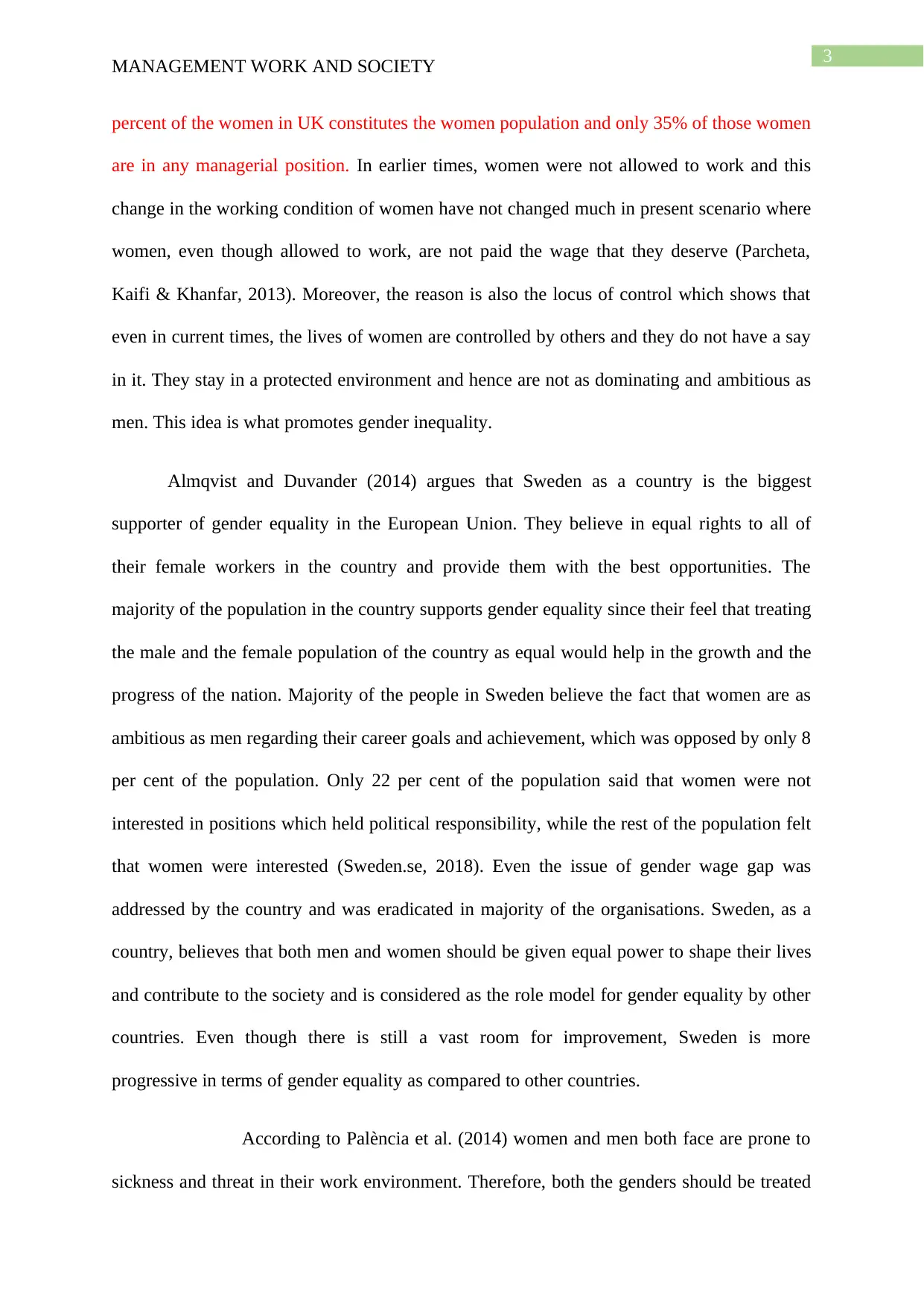
3
MANAGEMENT WORK AND SOCIETY
percent of the women in UK constitutes the women population and only 35% of those women
are in any managerial position. In earlier times, women were not allowed to work and this
change in the working condition of women have not changed much in present scenario where
women, even though allowed to work, are not paid the wage that they deserve (Parcheta,
Kaifi & Khanfar, 2013). Moreover, the reason is also the locus of control which shows that
even in current times, the lives of women are controlled by others and they do not have a say
in it. They stay in a protected environment and hence are not as dominating and ambitious as
men. This idea is what promotes gender inequality.
Almqvist and Duvander (2014) argues that Sweden as a country is the biggest
supporter of gender equality in the European Union. They believe in equal rights to all of
their female workers in the country and provide them with the best opportunities. The
majority of the population in the country supports gender equality since their feel that treating
the male and the female population of the country as equal would help in the growth and the
progress of the nation. Majority of the people in Sweden believe the fact that women are as
ambitious as men regarding their career goals and achievement, which was opposed by only 8
per cent of the population. Only 22 per cent of the population said that women were not
interested in positions which held political responsibility, while the rest of the population felt
that women were interested (Sweden.se, 2018). Even the issue of gender wage gap was
addressed by the country and was eradicated in majority of the organisations. Sweden, as a
country, believes that both men and women should be given equal power to shape their lives
and contribute to the society and is considered as the role model for gender equality by other
countries. Even though there is still a vast room for improvement, Sweden is more
progressive in terms of gender equality as compared to other countries.
According to Palència et al. (2014) women and men both face are prone to
sickness and threat in their work environment. Therefore, both the genders should be treated
MANAGEMENT WORK AND SOCIETY
percent of the women in UK constitutes the women population and only 35% of those women
are in any managerial position. In earlier times, women were not allowed to work and this
change in the working condition of women have not changed much in present scenario where
women, even though allowed to work, are not paid the wage that they deserve (Parcheta,
Kaifi & Khanfar, 2013). Moreover, the reason is also the locus of control which shows that
even in current times, the lives of women are controlled by others and they do not have a say
in it. They stay in a protected environment and hence are not as dominating and ambitious as
men. This idea is what promotes gender inequality.
Almqvist and Duvander (2014) argues that Sweden as a country is the biggest
supporter of gender equality in the European Union. They believe in equal rights to all of
their female workers in the country and provide them with the best opportunities. The
majority of the population in the country supports gender equality since their feel that treating
the male and the female population of the country as equal would help in the growth and the
progress of the nation. Majority of the people in Sweden believe the fact that women are as
ambitious as men regarding their career goals and achievement, which was opposed by only 8
per cent of the population. Only 22 per cent of the population said that women were not
interested in positions which held political responsibility, while the rest of the population felt
that women were interested (Sweden.se, 2018). Even the issue of gender wage gap was
addressed by the country and was eradicated in majority of the organisations. Sweden, as a
country, believes that both men and women should be given equal power to shape their lives
and contribute to the society and is considered as the role model for gender equality by other
countries. Even though there is still a vast room for improvement, Sweden is more
progressive in terms of gender equality as compared to other countries.
According to Palència et al. (2014) women and men both face are prone to
sickness and threat in their work environment. Therefore, both the genders should be treated
Secure Best Marks with AI Grader
Need help grading? Try our AI Grader for instant feedback on your assignments.
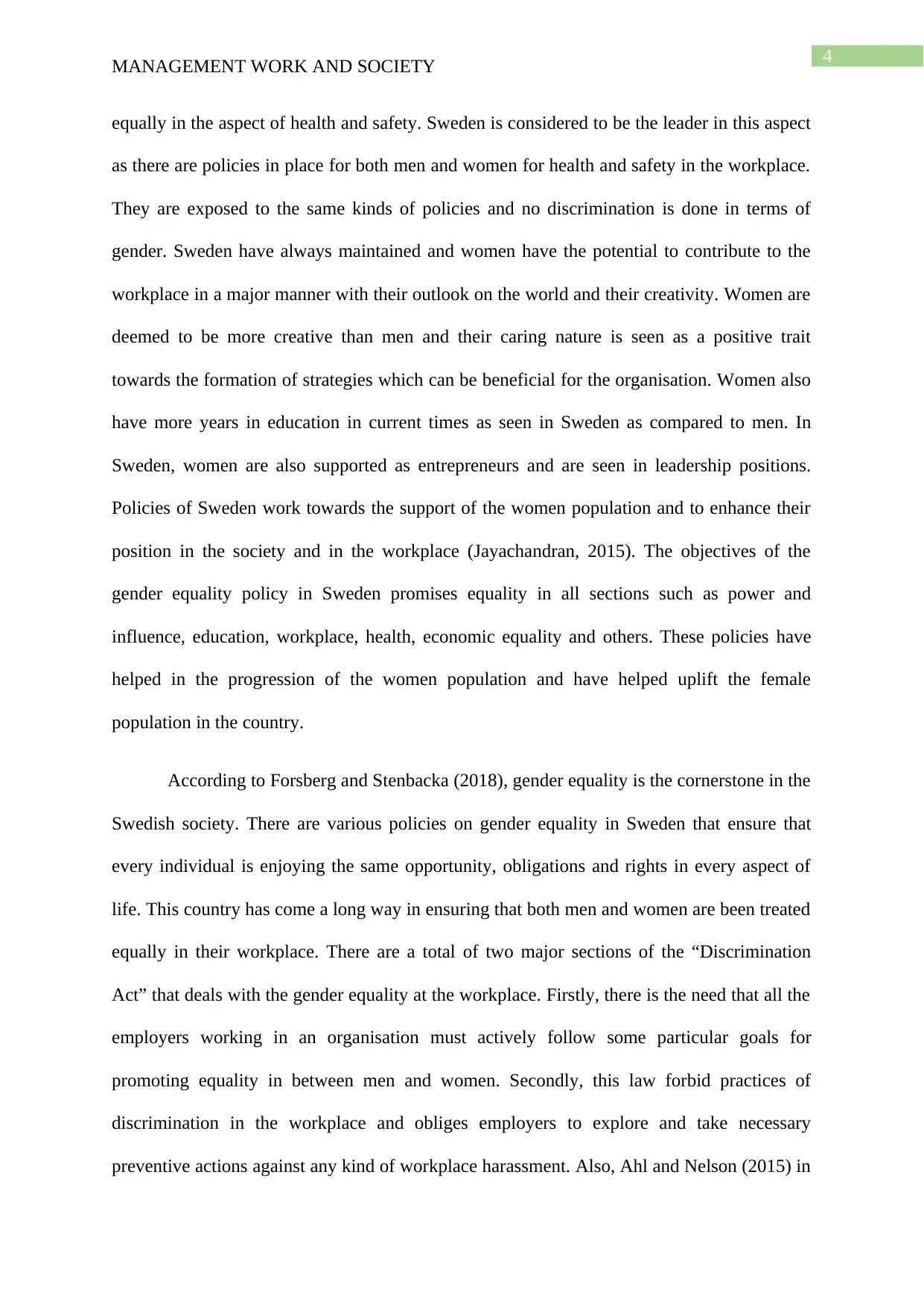
4
MANAGEMENT WORK AND SOCIETY
equally in the aspect of health and safety. Sweden is considered to be the leader in this aspect
as there are policies in place for both men and women for health and safety in the workplace.
They are exposed to the same kinds of policies and no discrimination is done in terms of
gender. Sweden have always maintained and women have the potential to contribute to the
workplace in a major manner with their outlook on the world and their creativity. Women are
deemed to be more creative than men and their caring nature is seen as a positive trait
towards the formation of strategies which can be beneficial for the organisation. Women also
have more years in education in current times as seen in Sweden as compared to men. In
Sweden, women are also supported as entrepreneurs and are seen in leadership positions.
Policies of Sweden work towards the support of the women population and to enhance their
position in the society and in the workplace (Jayachandran, 2015). The objectives of the
gender equality policy in Sweden promises equality in all sections such as power and
influence, education, workplace, health, economic equality and others. These policies have
helped in the progression of the women population and have helped uplift the female
population in the country.
According to Forsberg and Stenbacka (2018), gender equality is the cornerstone in the
Swedish society. There are various policies on gender equality in Sweden that ensure that
every individual is enjoying the same opportunity, obligations and rights in every aspect of
life. This country has come a long way in ensuring that both men and women are been treated
equally in their workplace. There are a total of two major sections of the “Discrimination
Act” that deals with the gender equality at the workplace. Firstly, there is the need that all the
employers working in an organisation must actively follow some particular goals for
promoting equality in between men and women. Secondly, this law forbid practices of
discrimination in the workplace and obliges employers to explore and take necessary
preventive actions against any kind of workplace harassment. Also, Ahl and Nelson (2015) in
MANAGEMENT WORK AND SOCIETY
equally in the aspect of health and safety. Sweden is considered to be the leader in this aspect
as there are policies in place for both men and women for health and safety in the workplace.
They are exposed to the same kinds of policies and no discrimination is done in terms of
gender. Sweden have always maintained and women have the potential to contribute to the
workplace in a major manner with their outlook on the world and their creativity. Women are
deemed to be more creative than men and their caring nature is seen as a positive trait
towards the formation of strategies which can be beneficial for the organisation. Women also
have more years in education in current times as seen in Sweden as compared to men. In
Sweden, women are also supported as entrepreneurs and are seen in leadership positions.
Policies of Sweden work towards the support of the women population and to enhance their
position in the society and in the workplace (Jayachandran, 2015). The objectives of the
gender equality policy in Sweden promises equality in all sections such as power and
influence, education, workplace, health, economic equality and others. These policies have
helped in the progression of the women population and have helped uplift the female
population in the country.
According to Forsberg and Stenbacka (2018), gender equality is the cornerstone in the
Swedish society. There are various policies on gender equality in Sweden that ensure that
every individual is enjoying the same opportunity, obligations and rights in every aspect of
life. This country has come a long way in ensuring that both men and women are been treated
equally in their workplace. There are a total of two major sections of the “Discrimination
Act” that deals with the gender equality at the workplace. Firstly, there is the need that all the
employers working in an organisation must actively follow some particular goals for
promoting equality in between men and women. Secondly, this law forbid practices of
discrimination in the workplace and obliges employers to explore and take necessary
preventive actions against any kind of workplace harassment. Also, Ahl and Nelson (2015) in
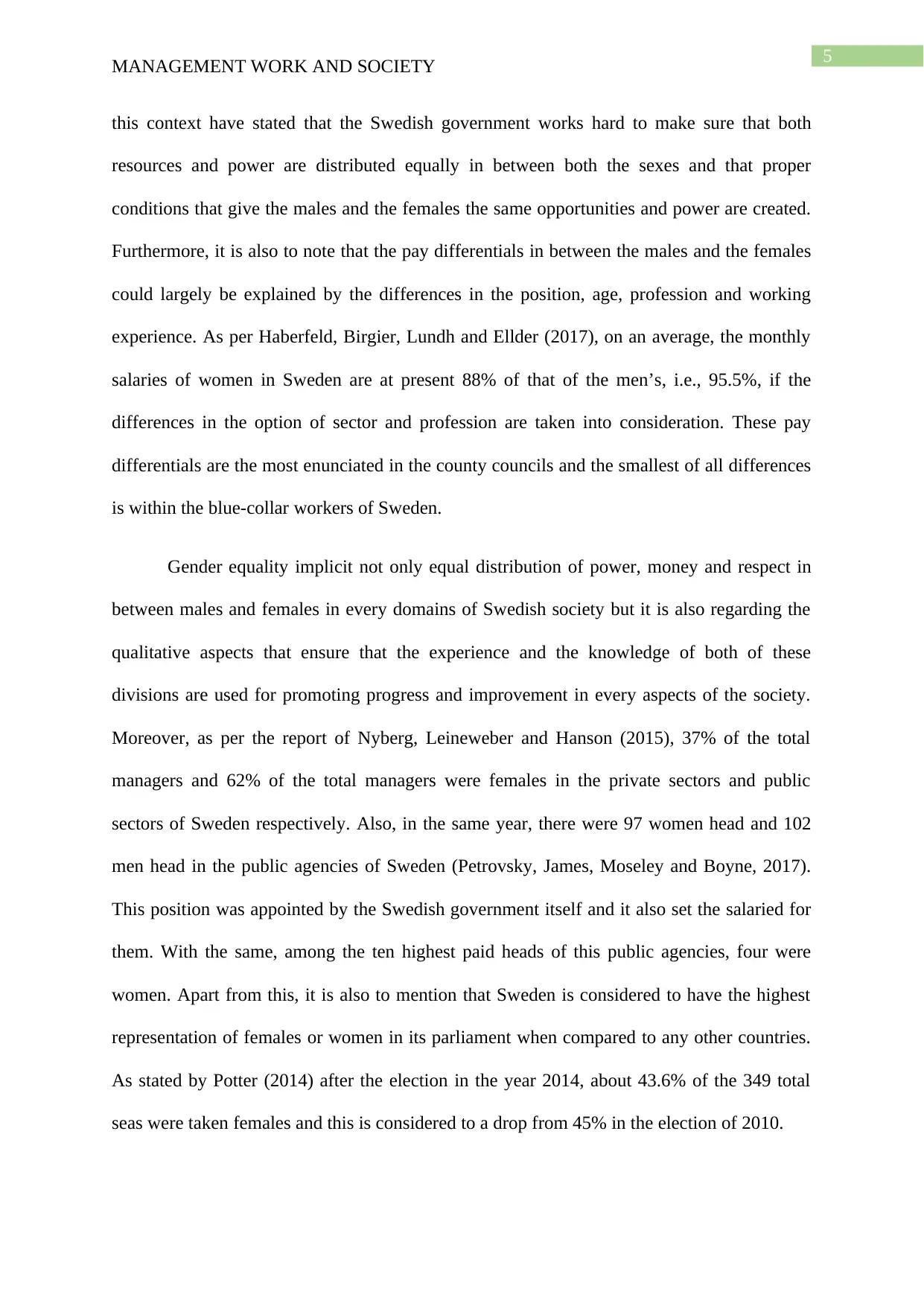
5
MANAGEMENT WORK AND SOCIETY
this context have stated that the Swedish government works hard to make sure that both
resources and power are distributed equally in between both the sexes and that proper
conditions that give the males and the females the same opportunities and power are created.
Furthermore, it is also to note that the pay differentials in between the males and the females
could largely be explained by the differences in the position, age, profession and working
experience. As per Haberfeld, Birgier, Lundh and Ellder (2017), on an average, the monthly
salaries of women in Sweden are at present 88% of that of the men’s, i.e., 95.5%, if the
differences in the option of sector and profession are taken into consideration. These pay
differentials are the most enunciated in the county councils and the smallest of all differences
is within the blue-collar workers of Sweden.
Gender equality implicit not only equal distribution of power, money and respect in
between males and females in every domains of Swedish society but it is also regarding the
qualitative aspects that ensure that the experience and the knowledge of both of these
divisions are used for promoting progress and improvement in every aspects of the society.
Moreover, as per the report of Nyberg, Leineweber and Hanson (2015), 37% of the total
managers and 62% of the total managers were females in the private sectors and public
sectors of Sweden respectively. Also, in the same year, there were 97 women head and 102
men head in the public agencies of Sweden (Petrovsky, James, Moseley and Boyne, 2017).
This position was appointed by the Swedish government itself and it also set the salaried for
them. With the same, among the ten highest paid heads of this public agencies, four were
women. Apart from this, it is also to mention that Sweden is considered to have the highest
representation of females or women in its parliament when compared to any other countries.
As stated by Potter (2014) after the election in the year 2014, about 43.6% of the 349 total
seas were taken females and this is considered to a drop from 45% in the election of 2010.
MANAGEMENT WORK AND SOCIETY
this context have stated that the Swedish government works hard to make sure that both
resources and power are distributed equally in between both the sexes and that proper
conditions that give the males and the females the same opportunities and power are created.
Furthermore, it is also to note that the pay differentials in between the males and the females
could largely be explained by the differences in the position, age, profession and working
experience. As per Haberfeld, Birgier, Lundh and Ellder (2017), on an average, the monthly
salaries of women in Sweden are at present 88% of that of the men’s, i.e., 95.5%, if the
differences in the option of sector and profession are taken into consideration. These pay
differentials are the most enunciated in the county councils and the smallest of all differences
is within the blue-collar workers of Sweden.
Gender equality implicit not only equal distribution of power, money and respect in
between males and females in every domains of Swedish society but it is also regarding the
qualitative aspects that ensure that the experience and the knowledge of both of these
divisions are used for promoting progress and improvement in every aspects of the society.
Moreover, as per the report of Nyberg, Leineweber and Hanson (2015), 37% of the total
managers and 62% of the total managers were females in the private sectors and public
sectors of Sweden respectively. Also, in the same year, there were 97 women head and 102
men head in the public agencies of Sweden (Petrovsky, James, Moseley and Boyne, 2017).
This position was appointed by the Swedish government itself and it also set the salaried for
them. With the same, among the ten highest paid heads of this public agencies, four were
women. Apart from this, it is also to mention that Sweden is considered to have the highest
representation of females or women in its parliament when compared to any other countries.
As stated by Potter (2014) after the election in the year 2014, about 43.6% of the 349 total
seas were taken females and this is considered to a drop from 45% in the election of 2010.
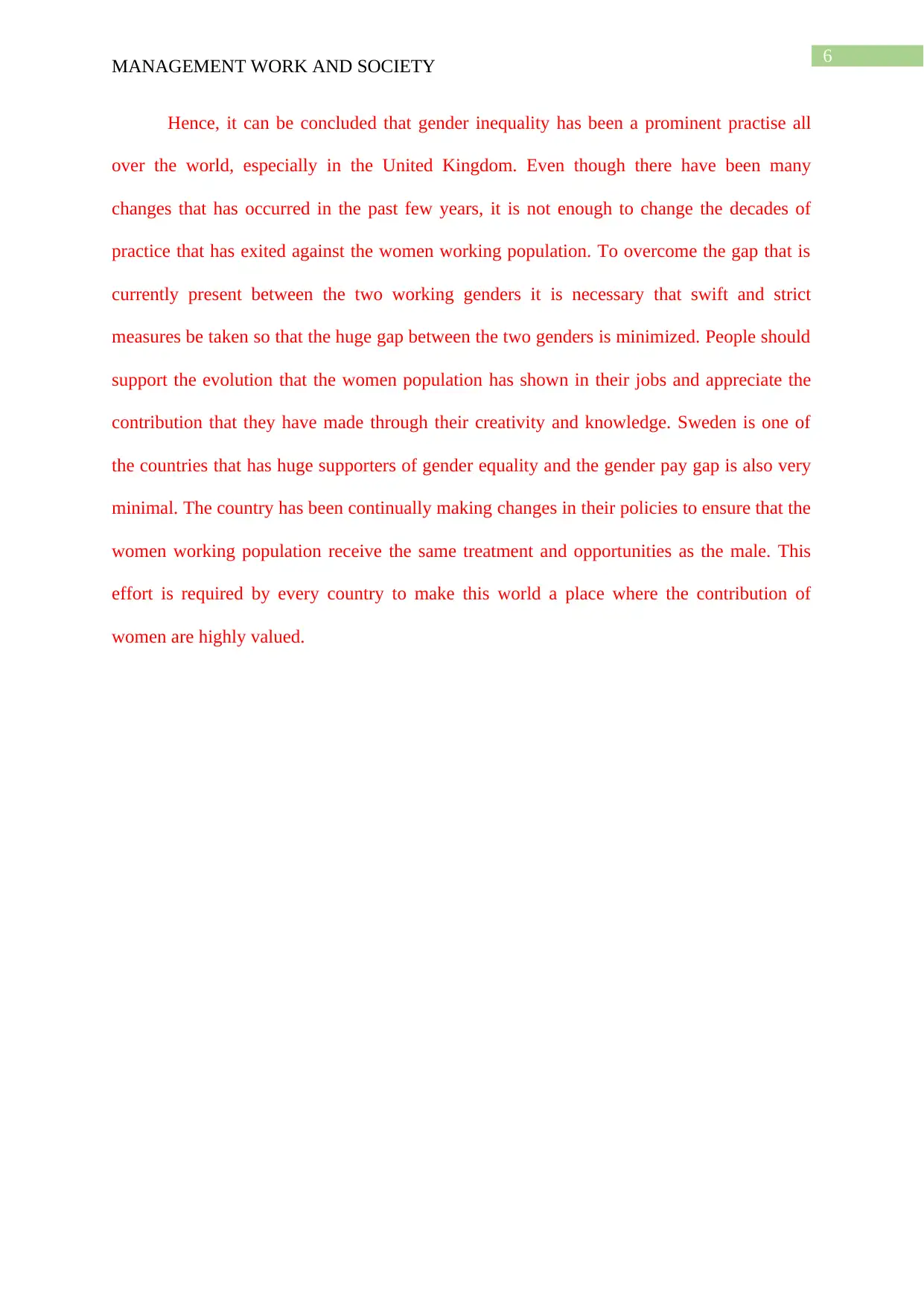
6
MANAGEMENT WORK AND SOCIETY
Hence, it can be concluded that gender inequality has been a prominent practise all
over the world, especially in the United Kingdom. Even though there have been many
changes that has occurred in the past few years, it is not enough to change the decades of
practice that has exited against the women working population. To overcome the gap that is
currently present between the two working genders it is necessary that swift and strict
measures be taken so that the huge gap between the two genders is minimized. People should
support the evolution that the women population has shown in their jobs and appreciate the
contribution that they have made through their creativity and knowledge. Sweden is one of
the countries that has huge supporters of gender equality and the gender pay gap is also very
minimal. The country has been continually making changes in their policies to ensure that the
women working population receive the same treatment and opportunities as the male. This
effort is required by every country to make this world a place where the contribution of
women are highly valued.
MANAGEMENT WORK AND SOCIETY
Hence, it can be concluded that gender inequality has been a prominent practise all
over the world, especially in the United Kingdom. Even though there have been many
changes that has occurred in the past few years, it is not enough to change the decades of
practice that has exited against the women working population. To overcome the gap that is
currently present between the two working genders it is necessary that swift and strict
measures be taken so that the huge gap between the two genders is minimized. People should
support the evolution that the women population has shown in their jobs and appreciate the
contribution that they have made through their creativity and knowledge. Sweden is one of
the countries that has huge supporters of gender equality and the gender pay gap is also very
minimal. The country has been continually making changes in their policies to ensure that the
women working population receive the same treatment and opportunities as the male. This
effort is required by every country to make this world a place where the contribution of
women are highly valued.
Paraphrase This Document
Need a fresh take? Get an instant paraphrase of this document with our AI Paraphraser
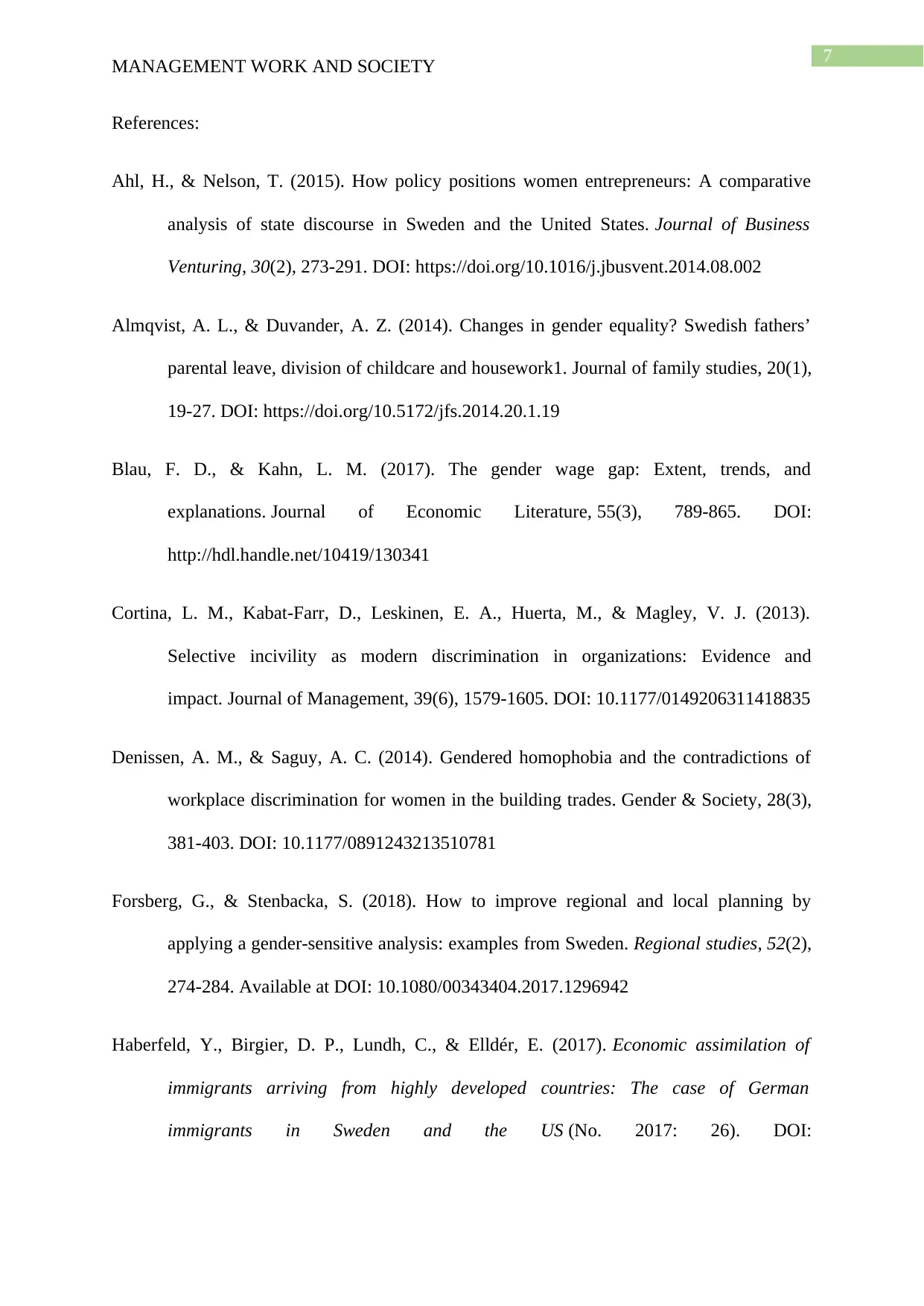
7
MANAGEMENT WORK AND SOCIETY
References:
Ahl, H., & Nelson, T. (2015). How policy positions women entrepreneurs: A comparative
analysis of state discourse in Sweden and the United States. Journal of Business
Venturing, 30(2), 273-291. DOI: https://doi.org/10.1016/j.jbusvent.2014.08.002
Almqvist, A. L., & Duvander, A. Z. (2014). Changes in gender equality? Swedish fathers’
parental leave, division of childcare and housework1. Journal of family studies, 20(1),
19-27. DOI: https://doi.org/10.5172/jfs.2014.20.1.19
Blau, F. D., & Kahn, L. M. (2017). The gender wage gap: Extent, trends, and
explanations. Journal of Economic Literature, 55(3), 789-865. DOI:
http://hdl.handle.net/10419/130341
Cortina, L. M., Kabat-Farr, D., Leskinen, E. A., Huerta, M., & Magley, V. J. (2013).
Selective incivility as modern discrimination in organizations: Evidence and
impact. Journal of Management, 39(6), 1579-1605. DOI: 10.1177/0149206311418835
Denissen, A. M., & Saguy, A. C. (2014). Gendered homophobia and the contradictions of
workplace discrimination for women in the building trades. Gender & Society, 28(3),
381-403. DOI: 10.1177/0891243213510781
Forsberg, G., & Stenbacka, S. (2018). How to improve regional and local planning by
applying a gender-sensitive analysis: examples from Sweden. Regional studies, 52(2),
274-284. Available at DOI: 10.1080/00343404.2017.1296942
Haberfeld, Y., Birgier, D. P., Lundh, C., & Elldér, E. (2017). Economic assimilation of
immigrants arriving from highly developed countries: The case of German
immigrants in Sweden and the US (No. 2017: 26). DOI:
MANAGEMENT WORK AND SOCIETY
References:
Ahl, H., & Nelson, T. (2015). How policy positions women entrepreneurs: A comparative
analysis of state discourse in Sweden and the United States. Journal of Business
Venturing, 30(2), 273-291. DOI: https://doi.org/10.1016/j.jbusvent.2014.08.002
Almqvist, A. L., & Duvander, A. Z. (2014). Changes in gender equality? Swedish fathers’
parental leave, division of childcare and housework1. Journal of family studies, 20(1),
19-27. DOI: https://doi.org/10.5172/jfs.2014.20.1.19
Blau, F. D., & Kahn, L. M. (2017). The gender wage gap: Extent, trends, and
explanations. Journal of Economic Literature, 55(3), 789-865. DOI:
http://hdl.handle.net/10419/130341
Cortina, L. M., Kabat-Farr, D., Leskinen, E. A., Huerta, M., & Magley, V. J. (2013).
Selective incivility as modern discrimination in organizations: Evidence and
impact. Journal of Management, 39(6), 1579-1605. DOI: 10.1177/0149206311418835
Denissen, A. M., & Saguy, A. C. (2014). Gendered homophobia and the contradictions of
workplace discrimination for women in the building trades. Gender & Society, 28(3),
381-403. DOI: 10.1177/0891243213510781
Forsberg, G., & Stenbacka, S. (2018). How to improve regional and local planning by
applying a gender-sensitive analysis: examples from Sweden. Regional studies, 52(2),
274-284. Available at DOI: 10.1080/00343404.2017.1296942
Haberfeld, Y., Birgier, D. P., Lundh, C., & Elldér, E. (2017). Economic assimilation of
immigrants arriving from highly developed countries: The case of German
immigrants in Sweden and the US (No. 2017: 26). DOI:
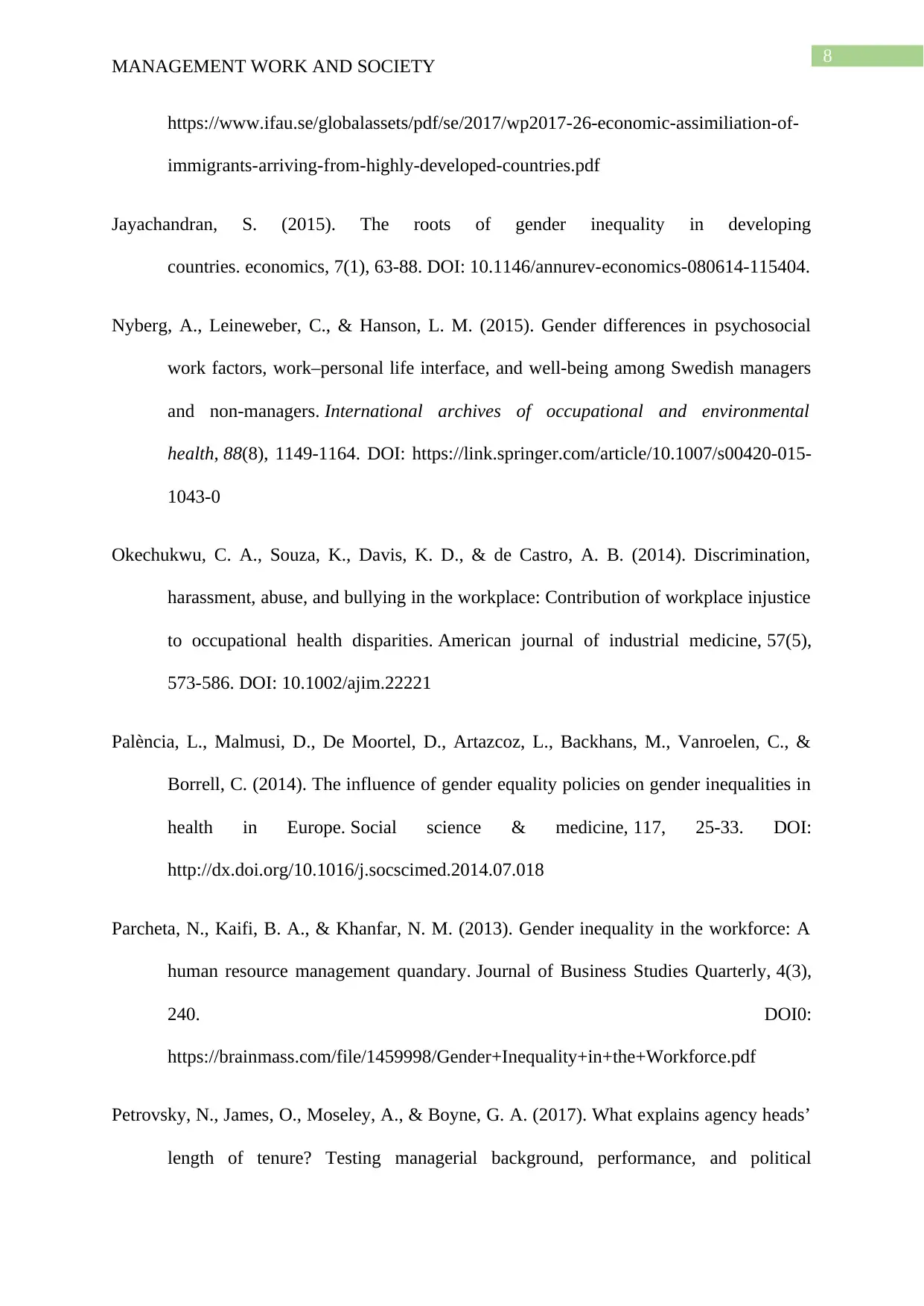
8
MANAGEMENT WORK AND SOCIETY
https://www.ifau.se/globalassets/pdf/se/2017/wp2017-26-economic-assimiliation-of-
immigrants-arriving-from-highly-developed-countries.pdf
Jayachandran, S. (2015). The roots of gender inequality in developing
countries. economics, 7(1), 63-88. DOI: 10.1146/annurev-economics-080614-115404.
Nyberg, A., Leineweber, C., & Hanson, L. M. (2015). Gender differences in psychosocial
work factors, work–personal life interface, and well-being among Swedish managers
and non-managers. International archives of occupational and environmental
health, 88(8), 1149-1164. DOI: https://link.springer.com/article/10.1007/s00420-015-
1043-0
Okechukwu, C. A., Souza, K., Davis, K. D., & de Castro, A. B. (2014). Discrimination,
harassment, abuse, and bullying in the workplace: Contribution of workplace injustice
to occupational health disparities. American journal of industrial medicine, 57(5),
573-586. DOI: 10.1002/ajim.22221
Palència, L., Malmusi, D., De Moortel, D., Artazcoz, L., Backhans, M., Vanroelen, C., &
Borrell, C. (2014). The influence of gender equality policies on gender inequalities in
health in Europe. Social science & medicine, 117, 25-33. DOI:
http://dx.doi.org/10.1016/j.socscimed.2014.07.018
Parcheta, N., Kaifi, B. A., & Khanfar, N. M. (2013). Gender inequality in the workforce: A
human resource management quandary. Journal of Business Studies Quarterly, 4(3),
240. DOI0:
https://brainmass.com/file/1459998/Gender+Inequality+in+the+Workforce.pdf
Petrovsky, N., James, O., Moseley, A., & Boyne, G. A. (2017). What explains agency heads’
length of tenure? Testing managerial background, performance, and political
MANAGEMENT WORK AND SOCIETY
https://www.ifau.se/globalassets/pdf/se/2017/wp2017-26-economic-assimiliation-of-
immigrants-arriving-from-highly-developed-countries.pdf
Jayachandran, S. (2015). The roots of gender inequality in developing
countries. economics, 7(1), 63-88. DOI: 10.1146/annurev-economics-080614-115404.
Nyberg, A., Leineweber, C., & Hanson, L. M. (2015). Gender differences in psychosocial
work factors, work–personal life interface, and well-being among Swedish managers
and non-managers. International archives of occupational and environmental
health, 88(8), 1149-1164. DOI: https://link.springer.com/article/10.1007/s00420-015-
1043-0
Okechukwu, C. A., Souza, K., Davis, K. D., & de Castro, A. B. (2014). Discrimination,
harassment, abuse, and bullying in the workplace: Contribution of workplace injustice
to occupational health disparities. American journal of industrial medicine, 57(5),
573-586. DOI: 10.1002/ajim.22221
Palència, L., Malmusi, D., De Moortel, D., Artazcoz, L., Backhans, M., Vanroelen, C., &
Borrell, C. (2014). The influence of gender equality policies on gender inequalities in
health in Europe. Social science & medicine, 117, 25-33. DOI:
http://dx.doi.org/10.1016/j.socscimed.2014.07.018
Parcheta, N., Kaifi, B. A., & Khanfar, N. M. (2013). Gender inequality in the workforce: A
human resource management quandary. Journal of Business Studies Quarterly, 4(3),
240. DOI0:
https://brainmass.com/file/1459998/Gender+Inequality+in+the+Workforce.pdf
Petrovsky, N., James, O., Moseley, A., & Boyne, G. A. (2017). What explains agency heads’
length of tenure? Testing managerial background, performance, and political
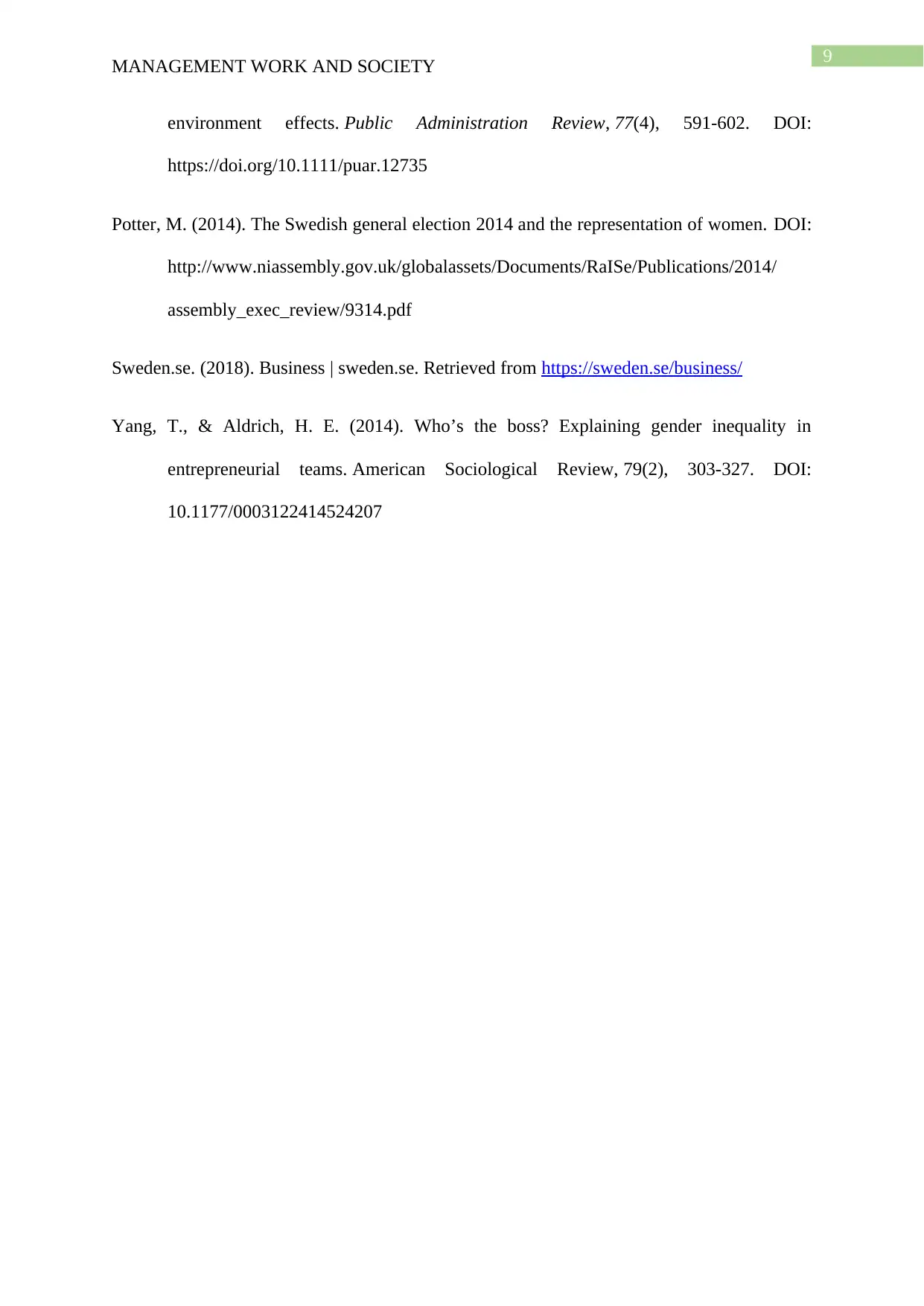
9
MANAGEMENT WORK AND SOCIETY
environment effects. Public Administration Review, 77(4), 591-602. DOI:
https://doi.org/10.1111/puar.12735
Potter, M. (2014). The Swedish general election 2014 and the representation of women. DOI:
http://www.niassembly.gov.uk/globalassets/Documents/RaISe/Publications/2014/
assembly_exec_review/9314.pdf
Sweden.se. (2018). Business | sweden.se. Retrieved from https://sweden.se/business/
Yang, T., & Aldrich, H. E. (2014). Who’s the boss? Explaining gender inequality in
entrepreneurial teams. American Sociological Review, 79(2), 303-327. DOI:
10.1177/0003122414524207
MANAGEMENT WORK AND SOCIETY
environment effects. Public Administration Review, 77(4), 591-602. DOI:
https://doi.org/10.1111/puar.12735
Potter, M. (2014). The Swedish general election 2014 and the representation of women. DOI:
http://www.niassembly.gov.uk/globalassets/Documents/RaISe/Publications/2014/
assembly_exec_review/9314.pdf
Sweden.se. (2018). Business | sweden.se. Retrieved from https://sweden.se/business/
Yang, T., & Aldrich, H. E. (2014). Who’s the boss? Explaining gender inequality in
entrepreneurial teams. American Sociological Review, 79(2), 303-327. DOI:
10.1177/0003122414524207
1 out of 10
Related Documents
Your All-in-One AI-Powered Toolkit for Academic Success.
+13062052269
info@desklib.com
Available 24*7 on WhatsApp / Email
![[object Object]](/_next/static/media/star-bottom.7253800d.svg)
Unlock your academic potential
© 2024 | Zucol Services PVT LTD | All rights reserved.





